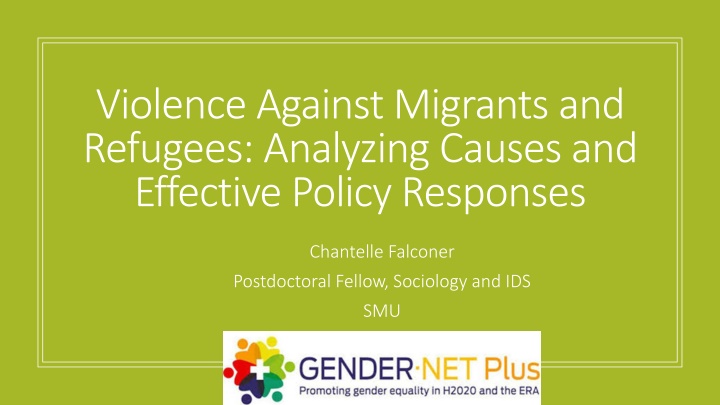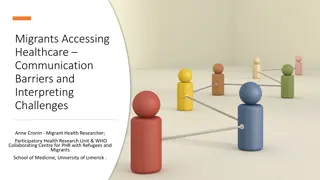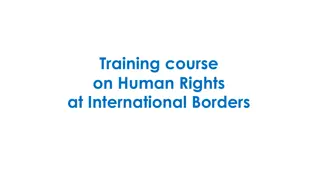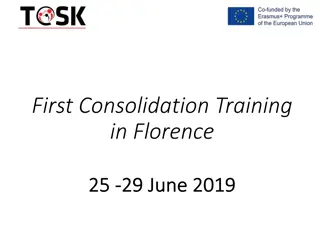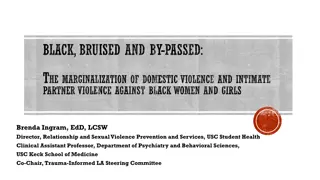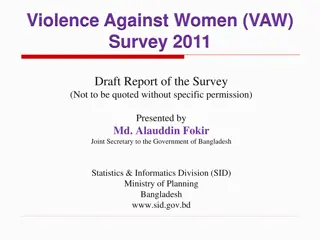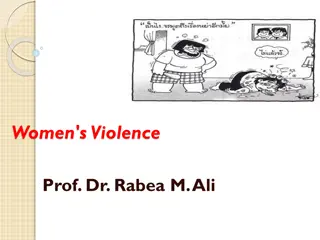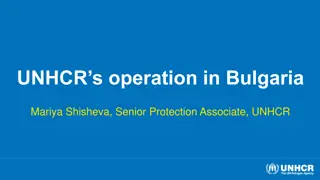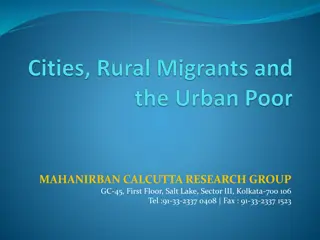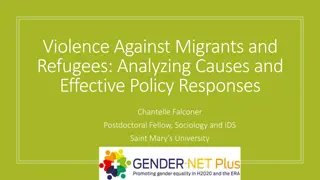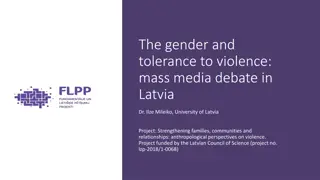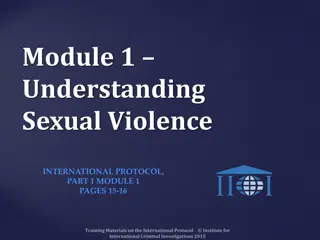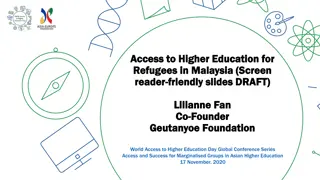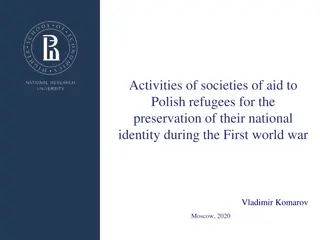Analyzing Violence Against Migrants and Refugees: Causes and Policy Responses
This project delves into gender-based violence, forced migration causes, intersectional vulnerabilities, and strategies to protect migrant and refugee women. It aims to understand underlying dynamics shaping violence patterns and explore effective policy responses.
Download Presentation

Please find below an Image/Link to download the presentation.
The content on the website is provided AS IS for your information and personal use only. It may not be sold, licensed, or shared on other websites without obtaining consent from the author.If you encounter any issues during the download, it is possible that the publisher has removed the file from their server.
You are allowed to download the files provided on this website for personal or commercial use, subject to the condition that they are used lawfully. All files are the property of their respective owners.
The content on the website is provided AS IS for your information and personal use only. It may not be sold, licensed, or shared on other websites without obtaining consent from the author.
E N D
Presentation Transcript
Violence Against Migrants and Refugees: Analyzing Causes and Effective Policy Responses Chantelle Falconer Postdoctoral Fellow, Sociology and IDS SMU
3 years 3 years 3 years Gender Gender- -Net Plus joint call on Gender and UN Sustainable Development Goals Net Plus joint call on Gender and UN Sustainable Development Goals International Consortium International Consortium Canadian Team: CIHR Canadian Team: CIHR- -funded funded
Gender- based violence (GBV) Violence directed against a person because of their gender. Constitutes a violation of human rights. Women and men experience gender-based violence but the majority of victims/survivors are women and girls. Worldwide, it is estimated that one in three women has experienced gendered violence in her lifetime by someone she knows
Cause of forced migration Tendency to overstate role of culture Barriers to asylum claims based on experiences of GBV During migration Settlement Immigration and integration policies Access to services GBV and Migration
Intersectional Approach This project analyzes the ways in which discriminations and inequalities the ways in which discriminations and inequalities based on gender, race, nationality, ethnicity, sexual orientation, gender identity and age, interact to make certain women more vulnerable to GBV and less able to access interact to make certain women more vulnerable to GBV and less able to access support and services for survivors than others. support and services for survivors than others.
Systematic and Comparative Approach What are the underlying dynamics that (re)produce patterns of violence?
What are migrant and refugees women individual and collective strategies for protecting themselves from GBV and dealing with the consequences of trauma and violence? Women as active agents Women Women Non-essentialist As position
Research Questions 1. How and in which ways are migrant and refugee women particularly vulnerable to GBV compared to women in the general population? How do changing gender relations in the course of migration influence the risks of GBV? How do intersections of discriminations and inequalities based on gender, race, ethnicity, nationality, religion, class and age, create risks of GBV? How do immigration, asylum, and settlement policies, impact women s risks and vulnerabilities to GBV? Do existing health, social and legal services in host countries respond adequately to the needs of migrant and refugee women who are victims of violence? How do migrant and refugee women protect themselves from the risks of SGBV? Which policy changes would be effective in reducing migrant and refugee women s risks of violence? 2. 3. 4. 5. 6. 7.
Dr. Evie Tastsoglou SMU Dr. Lori Wilkinson Canadian Team University of Manitoba Dr. Cathy Holtman University of New Brunswick Dr. Myrna Dawson Guelph University
Country Case Studies Canada Dr. Evangelia Tastsoglou Israel Dr. Ruth Halperin Kaddari France Dr. Jane Freedman Austria Dr. Sieglinde Rosenberger Ireland Dr. Niamh Reilly Turkey Dr. Gabriela Volfova Norway Dr. Magnum Bjornholt
4 Regions 4 Regions: Atlantic Quebec Ontario Western
Focus on gender, migration, GBV at regional, national, international scale Methods Survey academic literature Review grey literature Statistics Policy analysis NGO mapping Secondary Data
Methods Key informant interviews Semi-structed interviews with migrant and refugee women Primary Data
Current Project Stage Country review/Literature review Statistics Legal and policy frameworks Implementation Agents Dominant and public narratives REB application Establish advisory committee Participatory approach Website Any suggestions?
